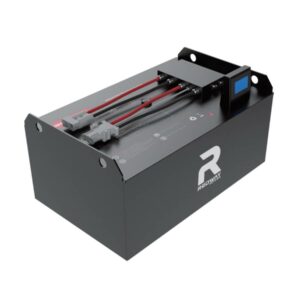
What Is a Motive Energy Deep Cycle Battery and How Does It Work
A Motive Energy Deep Cycle Battery is designed to provide sustained power for applications like electric vehicles, marine systems, and renewable energy storage. Unlike starter batteries, it delivers consistent energy over extended periods and withstands frequent deep discharges. These batteries use thick lead plates and advanced electrolytes for durability, making them ideal for high-demand, cyclic use scenarios.
How Do Motive Energy Deep Cycle Batteries Work?

Motive Energy Deep Cycle Batteries operate through electrochemical reactions between lead plates and sulfuric acid electrolyte. During discharge, lead dioxide (positive plate) and sponge lead (negative plate) react with sulfate ions, producing electricity. Recharging reverses this process, restoring the plates’ composition. Their thick plates and robust design enable repeated deep discharges (up to 80%) without significant capacity loss.
What Are the Key Applications of Motive Energy Deep Cycle Batteries?
These batteries power electric forklifts, golf carts, RVs, marine trolling motors, and solar energy storage systems. They excel in scenarios requiring long runtime, such as off-grid power setups, mobility scooters, and industrial equipment. Their ability to handle cyclic loads makes them indispensable for renewable energy integration and material handling operations.
How to Maintain a Motive Energy Deep Cycle Battery for Longevity?
Regular maintenance includes checking electrolyte levels (for flooded types), cleaning terminals to prevent corrosion, and ensuring full recharges after use. Avoid discharging below 50% capacity. Store in a cool, dry place and use a compatible smart charger. Equalize flooded batteries monthly to prevent sulfation. AGM and gel variants require less maintenance but need voltage-regulated charging.
Temperature plays a critical role in battery health. Avoid exposing batteries to extreme heat, which accelerates plate corrosion, or freezing conditions that reduce electrolyte efficiency. For flooded batteries, use distilled water to refill cells and never tap water, as minerals can degrade performance. Invest in a hydrometer to measure electrolyte density, which indicates charge state. A well-maintained battery can retain up to 90% of its original capacity after 500 cycles.
| Maintenance Task | Flooded Battery | AGM/Gel Battery |
|---|---|---|
| Electrolyte Check | Monthly | Not Required |
| Terminal Cleaning | Every 3 Months | Every 6 Months |
| Equalization | Monthly | Not Recommended |
How Do Motive Energy Batteries Compare to Lithium-Ion Alternatives?
Lead-acid Motive Energy Batteries are cost-effective upfront but heavier and less energy-dense than lithium-ion. Lithium variants offer longer lifespans (2,000+ cycles vs. 500-1,000 for lead-acid), faster charging, and higher efficiency. However, they cost 3x more initially. Choose lead-acid for budget-sensitive, high-power applications; opt for lithium for lightweight, high-cycle needs.
Lithium batteries maintain consistent voltage levels throughout discharge, unlike lead-acid, which experiences gradual voltage drops. This makes lithium ideal for precision equipment. However, lead-acid batteries excel in cold weather performance, operating reliably at -20°C, whereas lithium efficiency plummets below 0°C. For hybrid systems, some users combine both types: lithium for daily cycling and lead-acid for surge loads.
| Feature | Lead-Acid | Lithium-Ion |
|---|---|---|
| Cost per kWh | $150-$200 | $450-$600 |
| Weight (12V 100Ah) | 60-70 lbs | 25-30 lbs |
| Optimal Temp Range | -20°C to 50°C | 0°C to 45°C |
What Safety Precautions Are Critical for These Batteries?
Ventilate areas when charging flooded batteries to avoid hydrogen gas buildup. Wear protective gear when handling electrolytes. Prevent short circuits by insulating terminals. Use temperature-compensated chargers to avoid overheating. For lithium variants, employ battery management systems (BMS) to prevent thermal runaway. Always follow manufacturer guidelines for storage and disposal.
What Are the Environmental Impacts of Motive Energy Batteries?
Lead-acid batteries are 99% recyclable, but improper disposal risks soil/water contamination from lead and sulfuric acid. Lithium batteries pose fire risks if damaged but have lower toxicity. Recycling programs recover lead, lithium, and electrolytes. Opt for certified recyclers to minimize ecological harm and comply with regulations like the Battery Directive.
How to Choose the Right Motive Energy Battery for Your Needs?
Match voltage (6V, 12V, 24V) and capacity (Ah) to your system’s requirements. Calculate total daily energy consumption and add 20% buffer. For cyclic use, prioritize deep cycle rating (e.g., 500+ cycles). Consider weight limits—AGM/gel for vibration-prone environments, lithium for portability. Validate warranty terms (3-5 years for premium brands) and compatibility with existing chargers.
Expert Views
“Motive Energy Deep Cycle Batteries are evolving with hybrid designs blending lead-carbon chemistry for faster charging. We’re also seeing IoT integration for real-time health monitoring. While lithium dominates premium markets, lead-acid remains unbeaten for high-current, cost-driven applications. Proper maintenance can extend lifespan beyond 8 years in solar installations,” says a senior engineer at a leading battery manufacturer.
Conclusion
Motive Energy Deep Cycle Batteries are versatile power solutions for sustained energy delivery. By understanding their mechanics, applications, and maintenance protocols, users can optimize performance and lifespan. While lithium alternatives gain traction, lead-acid variants remain relevant for budget-conscious, high-power use cases. Always prioritize safety and environmental compliance when deploying these systems.
FAQs
- How Long Do Motive Energy Deep Cycle Batteries Last?
- Lifespan ranges from 4-8 years, depending on usage depth and maintenance. Lead-acid lasts 500-1,200 cycles at 50% discharge; lithium-ion exceeds 2,000 cycles. Regular charging and avoiding over-discharge maximize longevity.
- Can You Use a Car Charger for These Batteries?
- No. Car chargers use higher voltages optimized for starter batteries. Use a multi-stage smart charger with deep cycle profiles to prevent under/overcharging, which degrades capacity.
- Are AGM Batteries Better Than Flooded for Marine Use?
- Yes. AGM (Absorbent Glass Mat) batteries are spill-proof, vibration-resistant, and require no watering, making them ideal for marine environments. They also charge faster and handle deeper discharges than flooded types.
